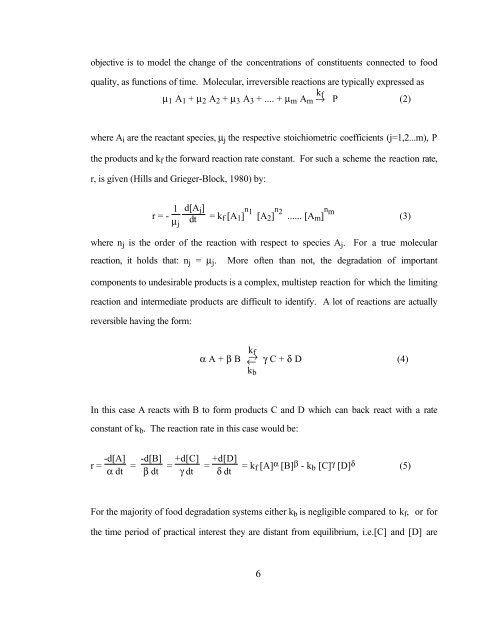the handbook of food engineering practice crc press chapter 10 ...
the handbook of food engineering practice crc press chapter 10 ...
the handbook of food engineering practice crc press chapter 10 ...
Create successful ePaper yourself
Turn your PDF publications into a flip-book with our unique Google optimized e-Paper software.
objective is to model <strong>the</strong> change <strong>of</strong> <strong>the</strong> concentrations <strong>of</strong> constituents connected to <strong>food</strong><br />
quality, as functions <strong>of</strong> time. Molecular, irreversible reactions are typically ex<strong>press</strong>ed as<br />
µ 1 A 1 + µ 2 A 2 + µ 3 A 3 + .... + µ m A m → k f<br />
P (2)<br />
where A i are <strong>the</strong> reactant species, µ j <strong>the</strong> respective stoichiometric coefficients (j=1,2...m), P<br />
<strong>the</strong> products and k f <strong>the</strong> forward reaction rate constant. For such a scheme <strong>the</strong> reaction rate,<br />
r, is given (Hills and Grieger-Block, 1980) by:<br />
r = - 1 µ j<br />
d[A j ]<br />
dt = k f [A 1 ] n 1<br />
[A 2 ] n 2 ...... [Am ] n m<br />
(3)<br />
where n j is <strong>the</strong> order <strong>of</strong> <strong>the</strong> reaction with respect to species A j . For a true molecular<br />
reaction, it holds that: n j = µ j . More <strong>of</strong>ten than not, <strong>the</strong> degradation <strong>of</strong> important<br />
components to undesirable products is a complex, multistep reaction for which <strong>the</strong> limiting<br />
reaction and intermediate products are difficult to identify. A lot <strong>of</strong> reactions are actually<br />
reversible having <strong>the</strong> form:<br />
α A + β B ←<br />
→ k f<br />
γ C + δ D (4)<br />
k b<br />
In this case A reacts with B to form products C and D which can back react with a rate<br />
constant <strong>of</strong> k b . The reaction rate in this case would be:<br />
r = -d[A]<br />
α dt<br />
= -d[B]<br />
β dt<br />
= +d[C]<br />
γ dt<br />
= +d[D]<br />
δ dt<br />
= k f [A] α [B] β - k b [C] γ [D] δ (5)<br />
For <strong>the</strong> majority <strong>of</strong> <strong>food</strong> degradation systems ei<strong>the</strong>r k b is negligible compared to k f , or for<br />
<strong>the</strong> time period <strong>of</strong> practical interest <strong>the</strong>y are distant from equilibrium, i.e.[C] and [D] are<br />
6














